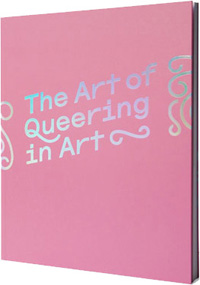MD: Picking up on the questions on terminology, in your talk on Oreet Ashery’s performance at The Whitstable Biennial, you used a couple of terms that were new to me. In your descriptions of the spectatorial reponse to her reenactments of the surreal acts of the controversial 17th century false messiah Shabtai Zvi, you spoke not only about pathos, but bathos and quathos.[8] Could you elaborate on the meaning of these terms? GB: This has actually come out in my work on the performances of Kiki and Herb, and I have written on it in the small-scale publication The Art of Queering in Art edited by Henry Rogers.[9] What got me thinking about this was the particular ways in which some contemporary queer performances solicit pathetic responses from their audiences. On one level, we feel that we should take the emotion that is being staged seriously. But at the same time, as in the Kiki and Herb example, it moves you, while at the same time undercutting that feeling. It undercuts the emotion that you feel at the same time as you feel it. That is the bathos, the undermining of the pathos. You have the empathy and the feeling, almost at the same time as you have the rug being pulled from under you. That’s where I introduce my queer theoretical take on that, to think about neither pathos nor bathos, but quathos. This is what I call a queer emotion, that is neither one nor the other, but a rather curious intermixing of the two, where you can’t decide what it is, how to take it, or how to feel. That’s a queer emotional moment. It is almost as if the one affect of pathos bleeds into the other. A point is also that quathos is a ridiculous term that clearly has a level of playfulness or glibness to it – a bit of a gag, really. I like that. I like the idea of doing conceptual theorizing as a stand-up comic. What does it mean to do theory as a practical joke? How would one think about joking as theorizing? MD: That would make theorizing much more fun! GB: It could be, but then it can also be so bloody difficult. That’s the kind of paradoxical and almost impossible nature of the project that I have set myself. MD: This brings us back to the importance on the paradoxical in your work. In your introduction to After Criticism: New Responses to Art and Performance, you write that criticism should aim at being paradoxical, not in the sense of being contradictory, but as being against doxa. GB: Yes, and the paradoxical is that which is so against received wisdom, as it is viewed with suspicion. It is so wide of the mark of how we conventionally think within consensus – the doxa of, let’s say, scholarly work – that it is very difficult to take it seriously. An example from history might be Marx and Engels’s famous use of the camera obscura-metaphor to describe ideology. They asserted that the world appears upside down in ideology, as in the image produced in a camera obscura. In a way this seems so crazy: that the world as we conventionally know it is a distortion, an upside down inverted representation of the real world. That is really weird, and so paradoxical as to be doubtful, that we can actually take it on board. I think that’s where critical ideas come from. The power of critical ideas is that they are para-doxical. Against doxa, beside doxa, they depart from doxa. And that’s why I still think and hope people see what I’m doing as that kind of a critical project. |  | ![[8] See Gavin Butt, “Should We Take Performance Seriously?” in Oreet Ashery, Dancing with Men, (London: Live Art Development Agency, 2009).](Resources/item1a3a1b1.gif)

![[9] Gavin Butt, “How I died for Kiki and Herb” in The Art of Queering in Art, Henry Rogers (ed.), (Birmingham: Article Press, 2007), pp. 85-94](Resources/item1a3a1b1a.gif)


|